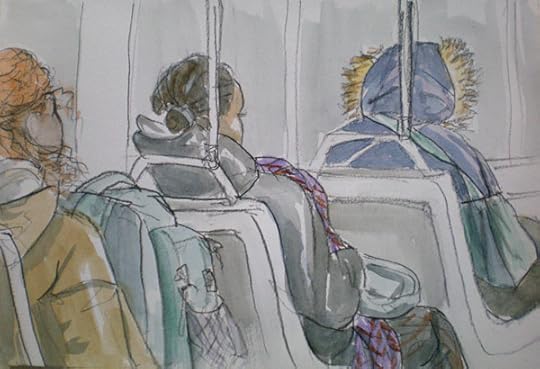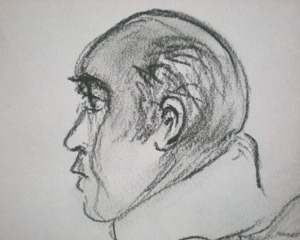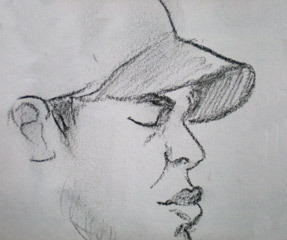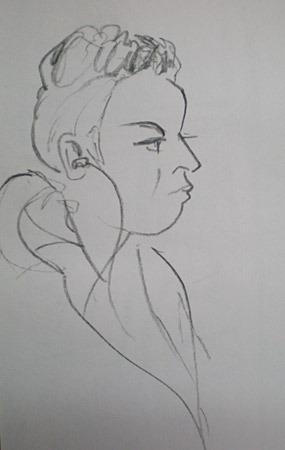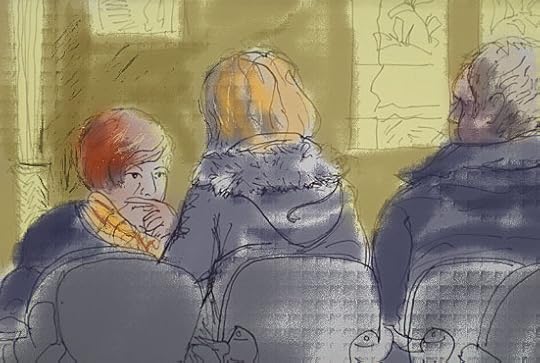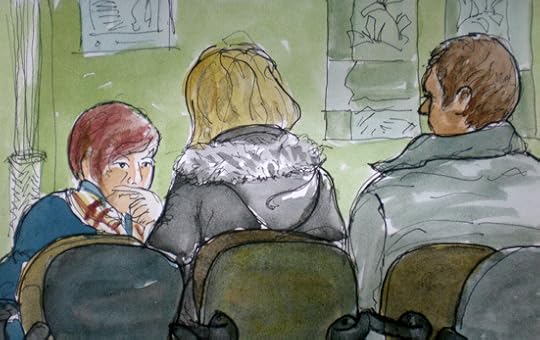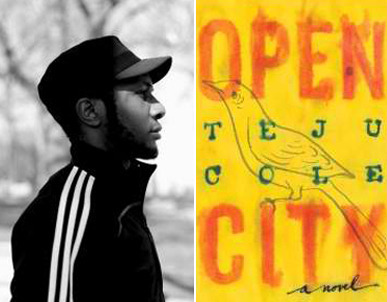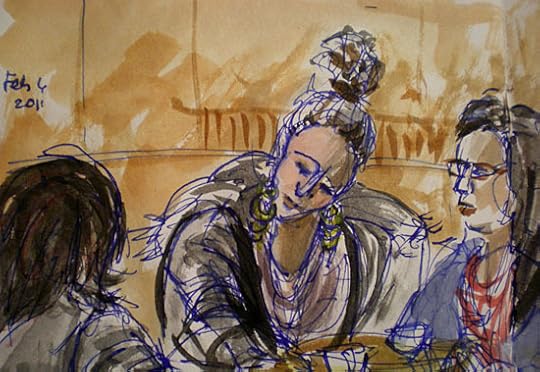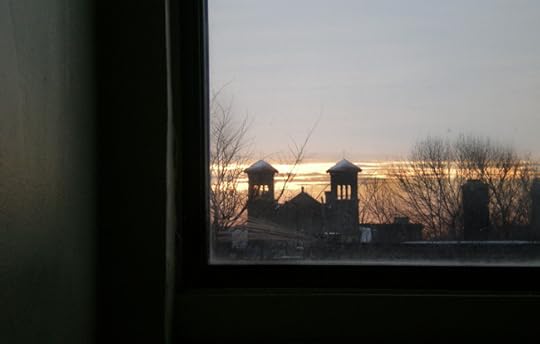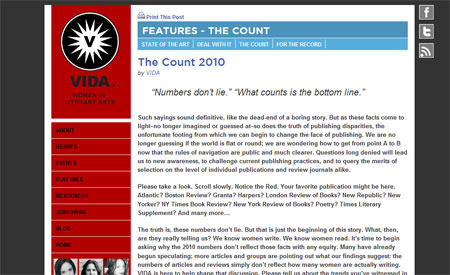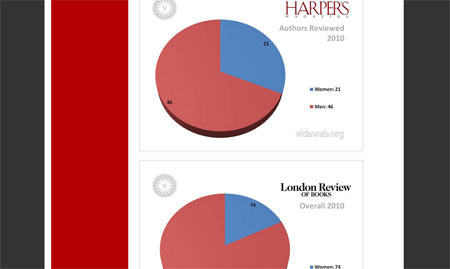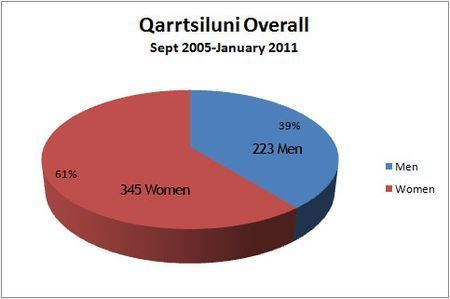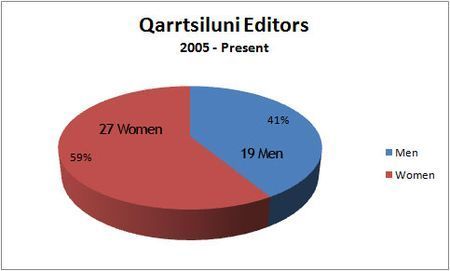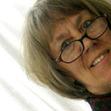Elizabeth Adams's Blog, page 123
February 11, 2011
Friday afternoon on the No. 10 bus
I liked the guy in the parka with his arm in a sling, and the middle woman's handknit scarf. Everybody was really quiet, just waiting to get home...
And a few other portrait sketches from recent trips on the metro:
The older asian man seemed really worried about something, couldn't stand still.
Sleeping: the best model!
Hip kid with earbuds, yellow hoodie, and a hairdo. He must have realized I was sketching him on the platform, because he stared at me from the other end of the car until I got off. Should have shown him the sketch.
February 9, 2011
Salle d'attente, clinique medicale
(1) color added in Photoshop
(2) "real" watercolor
(3) original drawing
I was waiting for J. at his annual exam, and got intrigued by this family that was waiting together. Then got further intrigued fooling around in Photoshop afterwards, with a Wacom tablet. I've loved seeing the art some people are doing on their IPads. Drawing and painting programs for computers, using tablets, have existed for a long time but I've never really taken advantage of them; here I was just working in Photoshop with texture, patterns, and brushes of various size and opacity. Working with a pressure-sensitive stylus feels fairly "normal"; I'm not sure how it compares to drawing directly on the screen with your finger. Will have to experiment.
February 8, 2011
Opening Day for Teju Cole's "Open City"
It's here.
Teju Cole's novel, Open City, published by Random House, launches today in bookstores and through online vendors, to numerous rave and perceptive reviews.
That will be no surprise to readers of this blog, who've been privileged from time to time to read Teju's essays here, illustrated with his photographs. I am absolutely thrilled about the publication of this so-called debut novel (those of us who read Every Day is For the Thief know that he already wrote, if not a full-length novel, a novella.) But regardless of marketing talk, and even regardless of my close friendship with the author, I feel confident in saying that Open City is a hugely accomplished novel that, I predict and hope, will mark the formal debut of a formidable literary career.
I was fortunate to be able to read early chapters in draft form, and then the entire book in manuscript. Open City is not a plot-driven novel, though there is a dark story that gradually emerges. Julius, the protagonist, is an emotionally-distant psychiatry resident in a New York hospital, and also an immigrant: the son of a German mother and African father. In order to shake off the work of his days, he takes to wandering the streets of the city at night. In luminous prose we follow his mind as he seeks to make connections between himself and the places he visits, as well as observing his strange disconnection to emotions and people: his former girlfriend, his neighbors, people he encounters. Only in his relationship to an aged Japanese professor do we find glimmers of a different possibility: a warmth and mutual interest that almost approach tenderness.
Parts of the book also take place in Brussels and in Lagos; and in all these descriptions of urban places and human encounters, both brief and extended, we are drawn into Julius' brilliant obsession with facts and history that has already reminded many reviewers of W.G. Sebald, at the same time as we ponder what appears more and more to be a self-imposed, even protective, psychological distance: why? What is he escaping or blotting out, and what does this say about the state of all immigrants, particularly in today's America?
As alien as Julius' character is to my own, I found him completely believable. The book's dialogue is vibrantly written, and the descriptive passages beautiful and full of telling detail, all of which advance the story even though its movement is not always apparent: a subtlety that is actually more true to life than the exaggeration of plot and character of most novels and films we've come to take for granted.
For me, the greatest accomplishment of this book is there, in the writing itself: the use of language, and most particularly, the control of narrative tone. Not only does Teju arrive on the New York literary scene with a first novel of great maturity, but he's doing so with a narrative voice that is quiet, meditative, and open. By open I mean that rather than filling his sentences and our minds with cleverness or dazzle, with fast-paced plot and action, with the breathlessness that mirrors our frantic, modern, western lives, he has left space -- much like the rests in music -- that allow the words to breathe and the reader to think. Frankly, this is not the fashion, in any of the arts today. But Teju has stepped back from the front of the stage, and written in his own way. I admire that, and know that it is neither the easy nor certain path. This type of prose can only emerge from deep sensitivity, silence, thought, and great attention to the craft of writing.
Teju, we all wish you the very best today: for Open City, and for wherever your wanderings, pen in hand, take you in the future. Thank you for the gift of your words.
More at Teju Cole's website and at Op Cit, a site about the novel.
February 6, 2011
Les Filles
In-between singing at the services today, I ate lunch, went to a bookstore, and had a cup of coffee at a cafe in the underground city, where I did this quick sketch of three young women at a table across the way. I was amused by the (typical Montreal) details: the central girl's big earrings and down parka with fur-trimmed hood (that she never took off) over a slinky silk-look top; the trendy glasses on the girl on the right; the crimson streaks in the straight black hair of the girl at left.
February 5, 2011
Winter Dawn over St-Pierre-Claver
February 3, 2011
Down for the Gender Count...or is it Up?
It all depends on where you look.
VIDA (Women in Literary Arts) has just released "The Count" - the past year's numbers showing how many women vs. men were published in a number of major literary magazines and reviews. The charts look at overall numbers of published authors, book reviewers, and authors reviewed. I knew there was a gender gap in traditional publishing, but I had no idea it was this great.
Some of us are certainly trying to address this, through our own publishing efforts, and through supporting and encouraging all writers, regardless of gender. With me, it hasn't been so much a conscious thing as simply trying to be fair when editing by choosing the best work, and trying to be kind to everyone who's trying to write and put themselves out there; it seems so obvious to me that women are doing at least half, if not more, of the excellent writing on the web. I'm glad that the online world seems to be ahead of the traditional print media on this issue: these stats are shocking.
Out of curiosity, I looked at the numbers and made some charts for qarrtsiluni, and my own press, Phoenicia Publishing.
During our entire history, from September 2005 to the present, qarrtsiluni has published 568 different authors and artists, of whom 61% were women and 39% were men.
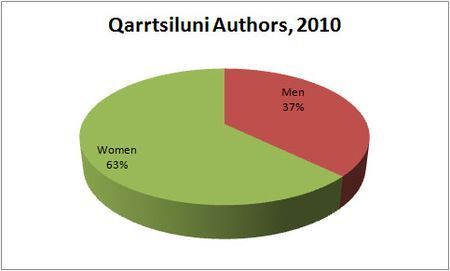
And the percentage of women is going up.
Counting the current issue, "Translation," the 2010 chapbook contest, and the three regular issues in 2010, recently qarrtsiluni has had 4 male editors and 7 female editors. The female editing majority may be partly responsible for the majority of women authors -- not so much, I think, because they are deliberately choosing work by women, but for two other factors.
Qarrtsiluni may have a greater number of total submissions from women writers than from men. We've reached out to the Wom-po (Women's Poetry) listserve and are pretty well-regarded in that circle; I actually don't know of a comparable male poets' group - does one exist? Likewise, editors often encourage or solicit submissions from their own circle of colleagues and friends, and I suppose it stands to reason that female editors might know more female writers than male. I don't have the stats yet for the current "Translation" issue, which had two male and two female editors, but I think that issue will be more evenly divided between male and female authors.
There's a support factor, too. When we notify authors that their work has gone up on the site, we encourage them to let their friends and family know; this increases traffic, and also increases comments, discussion, and sense of community. We've noticed that women authors tend to do this more than men -- is anyone surprised? If you'd like to see examples, take a look at two recent posts and their comment threads from "Translation" - Marly Youmans' "Two Poems from the Plant Kingdom," and Qavak Songs, translated by Nancy Campbell.
Now for a look at Phoenicia Publishing:
At Phoenicia, where a female editor (me!) is making all the decisions, current or planned titles are 23% by men, 31% by women, with anthologies or collections making up the rest.
-----
It's a relief to know that the publishing efforts I'm involved in don't reflect the same disparity as in traditional magazines, but a lot of questions arise and remain unanswered -- for instance, do men actually submit more work to Harper's, The Atlantic, Granta, etc, than women, or are these magazines simply choosing the big names, a majority of whom tend to be male? Who is making the editorial decisions - men or women? Do they feel that male authors represent a bigger "bottom line?"
Here's what my co-editor Dave Bonta has to say on this subject:
I simply feel that there are more women than men who are serious about creative writing in the U.S. these days, and that any magazine whose editors largely ignore credentials will publish men and women in roughly the same proportions as we do. Enough women are still doing the lion's share of housework and child-rearing to cut into their time for playing the submission game, if not for writing itself, and that would give men the edge in journals where the writer's vita is taken into account. Thus I suspect that elitist exclusivity is more to blame than sexism, though there's certainly plenty of evidence to show that many men and women may still harbor an unconscious bias whereby seriousness and importance as a writer are associated with having a schlong.
I suspect, too, that women writers may particularly value supportive journals which have a personal touch, and strive to cultivate a sense of community, and are less inclined to be satisfied solely with chalking up acceptances.
What do you think?
And to conclude, here's a final question: should we, who are working outside the publishing mainstream, put energy into trying to change this, or simply try to do the best job we can as we build alternative publishing systems for the future -- systems that are based on merit and on encouraging self-expression among all writers, regardless of gender?
(Thanks to Ren Powell for posting the original link to the VIDA stats on FB!)
February 1, 2011
A New Month
Well. Here I am again, fresh from my self-imposed month of blogging austerity: a month of small stones for bread.
It was good for me. I needed a different pace and different type of writing and thinking, and the discipline of small observed moments gave me just that. Several times during the month I was tempted to break in and write something expository, emotional, and longer: after Tucson, and about Egypt were just two examples. I even wrote the Tucson essay here and got it ready to post, and then told myself, "No." Egypt is an ongoing situation and I'll say something about it eventually, but it was good to just step back and stay the meditative course for one whole month.
Because I've observed Lent and, to a lesser extent, Advent for many years, it's not strange for me to "give things up" or keep to some sort of daily discipline, but that doesn't mean it's easy or natural. Making the observations is pretty easy, and writing something is a good but not foreign challenge. What's hard is not going into the other areas my mind often inhabits - the regions of opinions, judgments, arguments, where words can be used not only as pointers but as weapons, or proofs of cleverness and erudition. And partly because of that, I think I've found blogging exhausting sometimes, in the same way that coming up with a good meal and cooking it can be exhausting when one does it day after day, year after year; it doesn't mean you don't like cooking, it just means you've run dry. Writing the "stones" was like going on a fast that was simple, cleansing, and healing rather than a deprivation. I may try to incorporate it much mroe regularly into my writing life.
I'm grateful to Fiona for making "a river of stones" into a community event. I felt surrounded by other people doing the same thing, but not competing; and unlike National Poetry Month, when I often do something similar on my blog, this felt like a small and homey group, even though I didn't, and couldn't, follow a lot of other blogs, just those of friends who I knew were participating.
It also reminded me that I really like the medium of short poems or prose observations, as short as strictly formal 5-7-5 haiku and as long as a paragraph, and I especially loved making photographs or paintings either to illustrate the day's observed moment, or as a prompt for writing themselves. I hadn't expected to start doing the small watercolors again, but once I started with the blueberries, the others followed naturally, and it made me happy to work in that medium and style again; more ideas are in my head so I'm sure I'll be continuing with some more paintings.
The point, as Fiona said originally, is to slow down. I agree with her. It's not an escape from the world as it is, but a witness to our need to seek silence and to use our senses single-pointedly; not multi-tasking, but steeping back from sensory and emotional overload to look out, and look in.
January 31, 2011
31.
January 30, 2011
30.
My bright blue coat's the only color in the metro car. Exiting,I feel a little rush of love for my fellow Montrealers in their black and grey; perhaps it's the Sweelinck we've just sung, its unpredictable buoyancy -- or the earnest young stranger on the car telling his friends the miracle of voice lessons, the transformation a good teacher had made when the soft palette lifted and the sound changed completely: you can feel it, he said, looking at them in wonder, touching his forehead.

